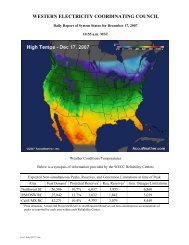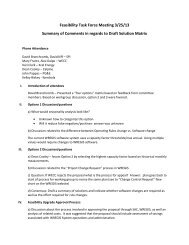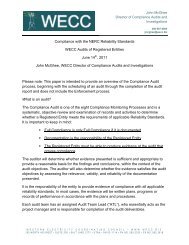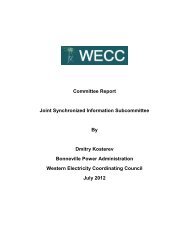Path Rating Catalog 2013 - Western Electricity Coordinating Council
Path Rating Catalog 2013 - Western Electricity Coordinating Council
Path Rating Catalog 2013 - Western Electricity Coordinating Council
Create successful ePaper yourself
Turn your PDF publications into a flip-book with our unique Google optimized e-Paper software.
simultaneous analysis, only heavy summer conditions were studied. For the<br />
<strong>Path</strong> 3 simultaneous analysis, both heavy summer and light spring<br />
conditions were studied. For the <strong>Path</strong> 8 simultaneous analysis, only light<br />
spring conditions were studied.<br />
Study Criteria:<br />
Remedial<br />
Actions<br />
Required:<br />
Formal<br />
Operating<br />
Procedure:<br />
For the 2012 wind addition sensitivity, <strong>Path</strong> 1 and <strong>Path</strong> 3 were studied<br />
using both heavy summer and light spring system conditions. <strong>Path</strong> 8 was<br />
not re-studied because the 2007 studies found no credible interactions.<br />
NERC Reliability Standards (TPL-001-0.1, TPL-002-0b, TPL-003-0a, and<br />
TPL-004-0), the WECC System Performance Criteria (TPL-001-WECC-<br />
CRT-2, effective December 01, 2011), and local AESO and NWE system<br />
criteria.<br />
A distributed remedial action scheme (RAS) is proposed for MATL. The<br />
primary objective of the RAS is to respond to a number of possible<br />
contingency events by separating Montana and Alberta, in order to prevent<br />
the development of instability. This purpose is accomplished as soon as<br />
either end of MATL is opened. However, when one end of MATL is<br />
opened, the other end should be opened as well. There are a number of<br />
reasons to do this, among which are operational restrictions imposed by the<br />
interconnected systems and equipment protection.<br />
MATL RAS is designed to operate for the specific contingencies listed<br />
below:<br />
1. Langdon-Cranbrook (<strong>Path</strong> 1)<br />
2. Cranbrook-Selkirk<br />
3. Ingledow-Custer (double circuit)<br />
4. 5L91 Ashton Creek-Selkirk & 5L96 Vaseux Lake-Selkirk (category C)<br />
5. 5L91 Ashton Creek-Selkirk & 5L98 Nicola-Vaseux Lake<br />
6. Custer-Monroe (double circuit)<br />
When either RAS unit at either location makes the decision to trip, it will<br />
open the circuit breaker at its location, disconnecting MATL at that end,<br />
and initiate the orderly shutdown sequence logic to trip each segment of the<br />
MATL system. An orderly shutdown sequence was developed as part of<br />
MATL's normal protection scheme for the purpose of ensuring that both<br />
ends open whenever one end does.<br />
There will be installations for the RAS at both the Great Falls and MATL<br />
120S substations. Each RAS installation shall be comprised of two<br />
independent intelligent electronic devices (IED) providing full redundancy<br />
and each RAS IED will be programmed to have the following two<br />
detection functions:<br />
• an under-voltage/over-power detection<br />
• an out-of-step detection<br />
The under-voltage/overpower detection will monitor the voltage and the<br />
apparent power at its installed location. When the voltage is below the<br />
setting threshold AND the apparent power is above the setting threshold for<br />
the specified length of time, a trip output will be issued by the RAS. The<br />
apparent power setting will be non-directional.<br />
The following operating procedures will be developed and shared with<br />
AESO, NWE and AltaLink prior to project energization:<br />
• MATL RAS/SPS Operating Procedure<br />
PART VI Item 1-217

















